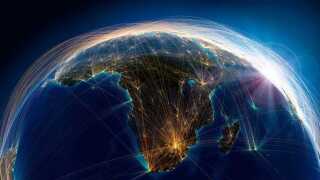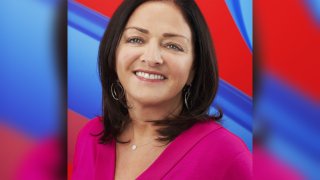With all eyes on the Nordics it’s no wonder that new infrastructure projects are cropping up at a rate faster than ever before.
In September, DigiPlex broke ground on the construction of two new data centres near Oslo, Norway. Bulk Infrastructure AS launched its Nordic Gateway, an on-ramp solution into the Havfrue Cable System. Cinia green-lit its €700 million Arctic Connect cable in collaboration with MegaFon and in 2018, Google announced plans to open a new €600 million green data centre in Fredericia, Denmark, the first for the company in the country.
One of the more hotly anticipated projects is the construction of Celtic Norse, a 2,000km cable linking the city of Øysanden, in Norway, just south of the city of Trondheim and Killala Bay, County Mayo in the Republic of Ireland.
How did the project come about? Well it all goes back to 2015, up in the Norwegian mountains with three representatives from one of the major over the tops (OTTs) looking at the Akrestømmen site as a potential location for a hosting campus.
“Through that process, which was a steep learning curve, it showed us that we were woefully inadequate and unprepared to answer questions about international connectivity,” explains Erling Aronsveen, CEO of Celtic Norse. “That whole experience of answering their demands for data centre space, got us into developing our own subsea cable.”
Firmly at the helm of this new system Aronsveen says the new cable will create much needed connectivity and lower latency for the region.
“The Celtic Norse sea cable will enable regional Norway to connect its attractive sites and vast renewable power resources to Europe and America with better response times to Eastern Seaboard US than anywhere else in the Nordic region.” According to the executive, there is plenty of land and power to accommodate hyperscale data centres in Norway, but the international connectivity is not yet optimal enough.
“At present, all fibre in central Norway is routed through Oslo, but that won’t do for data centres,” he explains. “What we’re proposing to our owners and other utility companies in this part of Norway is to build our own cable. In doing so we are making Trondheim a landing point for international connectivity with almost direct connectivity to the US. Plus, with the landing in Ireland we will also reach those data centre markets.”
Additionally, from a backhaul perspective, as a member of the EasyFibre consortium, Celtic Norse is well placed to offer unique benefits to its customers.
“We are part of a terrestrial fibre consortium in the Nordics called EasyFibre. It is made up of roughly 12 different fibre owners that have pooled all their fibre together into a dark fibre value proposition,” he says. “For the OTTs or anyone who wants to do anything in this region, you don’t have to wade through all the different companies who have fibre. It’s a one-stop shop. As for the Celtic Norse cable we can just draw on our partners and do great stuff for this cable on the terrestrial fibre side of things.”
Unlike traditional cables built with anchor tenants, Celtic Norse will leverage “the organisations, the municipalities and those that stand to benefit from this, to invest in this system,” says Aronsveen.
Though no official figures have been given, Aronsveen estimates the total cost for the development of the system to be just below 500 million NOK (approximately $57 million). But the development of the project took a big turn in July 2019, when the company announced that it had been partly acquired by three energy suppliers. NTE, TrønderEnergi and Nordavind DC Sites AS each acquired a 1/3 of Celtic Norse with each new owner all holding regional grid operations, hydroelectric and wind power production, as well as fibre-optic operations in the region. Together, they have combined company revenues of close to €400 million per year.
“Celtic Norse is currently owned by three utility, energy producers in Norway. They do not have any special interest in subsea cables or international connectivity. What they do have is an interest in providing fibre and providing hydroelectric and wind power to facilities in their producing region. This is why they have ventured into Celtic Norse. They all have long-haul fibre networks at the proposed landing stations and this new system will add to their offerings,” explains Aronsveen.
All three shareholders will fund Celtic Norse AS up until funding is secured and the project is completed, which is due to take place by the end of 2021.
The most recent development in the project came during Capacity Europe this past October. Celtic Norse announced that it is working with Vodafone Iceland and Scotland’s infrastructure body, the Scottish Futures Trust and Host in Scotland, the data centre body that it sponsors, on two branch cables landing in both countries. The first in Irvine, in the town on the West coast of Scotland, and the second in Grindavík, a fishing town on the Southern Peninsula of Iceland.
“Having branch partners in the geographical regions, adds both credibility to the project in terms of getting financing together and it also adds value to the system once its built,” Aronseen says. “It means you can branch capacity into different places. For example, the capacity sales between Iceland and Norway, though it’s not something we’re into yet, it’s definitely something worth considering.”
Celtic Norse will enter into a joint build agreement with the branching partners and have everything built at the same time as it “generally costs you more when you do it afterwards”, Aronsveen explains.
The news also means that Celtic Norse will be working with Aqua Comms as its operations partner for the venture, leveraging much of the company’s existing assets and capabilities. “We’ve got a NOC, we’ve got engineers, we’ve got capabilities, we’ve got insurances and, a whole range of things,” said Nigel Bayliff, CEO, Aqua Comms.
Aronsveen adds: “Celtic Norse will not try to build an operation like Aqua Comms, we’re not competing, which is why we are working with them.”
Interestingly, Bayliff says that in effect Celtic Norse is adding to Aqua Comms’ North Atlantic Loop in the region.
“If you look at the North Atlantic Loop, this adds Norway to the loop. It looks like a cable between two points but in reality, it’s a segment of a whole loop-based architecture,” he says.
“That resilience is even more important once those older systems across the Atlantic start to shut down because the number of options along this route will decrease over the next few years,” continues Aronsveen.
The final details on the specifications of the system have yet to be given although Aronsveen confirms, “We are looking into eight pair systems, notionally 20Tbps per pair. It will serve Norway’s data centre needs of the Norway, together with the new branches for next couple of decades.”
Though route diversity in the fight against aging systems is a key driver for Celtic Norse, the other is latency, saving its customers up to 30% in comparison to existing systems.
“One of the main reasons we decided to go into this venture in the first place was to eliminate the disadvantages,” Aronsveen says. “If you want to go from the middle of Norway to New York today, you will have to get down to the continent and then down to London and then across the Atlantic and that’s more expensive. This will move Norway, Scotland and Iceland a thousand kilometres closer to New York than they are now.”
As far as the progress of the project goes, the company completed a request for information in June 2019 and into a request for price (RFP) on 30 September. The desktop study (DTS) was completed in October last year (2018). December/January 2020 is the date set for the decision point investment, design and manufacturing, with installation and ready for service (RFS) by winter 2021.
“Celtic Norse heads into the RFP with the confidence that a vendor will be selected to build the system by the end of December 2019 and the final stages of financing will be complete with the significant advantage of having a contract signed for a turn-key build,” he says.
Unlike most of his peers, Aronsveen seems less concerned about the participation or opinion of the OTTs in the new system. Instead, its all about putting Norway and its forward landing points firmly on the map and at the centre of international connectivity.
“Our goal is not to just chase the OTTs, There’s a broader history to be written about taking a part of a country that is connected to the internet but not an international hub and trying to make it into one.”









